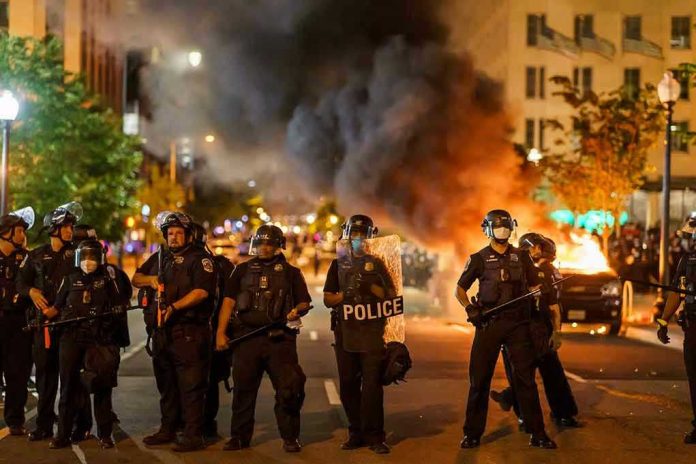
Peru’s interim president refuses to step down despite Generation Z protesters dying in the streets, revealing a dangerous collision between digital-native activism and entrenched political corruption that could reshape Latin American democracy.
Story Snapshot
- Generation Z protesters led massive demonstrations demanding President José Jerí’s resignation, resulting in one death and over 100 injuries
- The unrest followed rapid-fire impeachments of two presidents within weeks, exposing Peru’s chronic political instability
- Digital activists launched cyber-attacks against government websites while organizing street protests through social media
- Police used tear gas and rubber bullets against demonstrators, with cyber-activists retaliating by doxxing officers online
- Congress and the presidency maintain record-low approval ratings above 90%, indicating complete institutional collapse
When Digital Natives Take to the Streets
Generation Z protesters in Peru wielded smartphones like weapons, coordinating massive demonstrations through encrypted messaging apps while simultaneously launching cyber-attacks against government websites. These digital-native activists understand something their predecessors didn’t: modern revolutions require both physical presence and virtual warfare. They organized flash mobs, disseminated real-time police brutality footage, and doxxed officers who used excessive force, creating a two-front battle that caught authorities completely off-guard.
The sophistication of their approach reveals a generational shift in political resistance. Unlike previous protest movements that relied on traditional media and established organizations, these young Peruvians bypassed gatekeepers entirely. They created their own news cycles, documented their own abuses, and built their own networks of support through platforms the government barely understands, much less controls.
The Rapid Collapse of Presidential Authority
José Jerí became Peru’s interim president on October 10, 2025, after Congress impeached Dina Boluarte for “permanent moral incapacity.” Within days, he faced the same fury that toppled his predecessor. This lightning-fast cycle of political destruction demonstrates how completely Peruvian institutions have lost legitimacy. When 93% of citizens disapprove of their president and over 90% reject Congress, democratic governance becomes impossible.
The speed of these political collapses reflects more than mere institutional weakness; it reveals a complete breakdown in the social contract between rulers and ruled. Traditional political elites, accustomed to managing dissent through conventional channels, find themselves powerless against movements that operate outside established frameworks. Jerí’s refusal to resign despite mounting casualties suggests either remarkable political courage or dangerous detachment from reality.
Violent Anti-Crime Protests in Peru Leave One Dead as Government Fails to Quell Unrest https://t.co/yg6MPCu4Pk
— Amb Antonio Garza (@aogarza) October 17, 2025
Blood in the Streets, Chaos in Cyberspace
Eduardo Ruiz, a 32-year-old protester, became the movement’s first martyr when police violence escalated on October 15, 2025. His death transformed what began as anti-corruption demonstrations into something far more dangerous: a generational war against the entire political establishment. Over 100 people suffered injuries as police deployed tear gas and rubber bullets against crowds that included teenagers and young adults with nothing left to lose.
The violence triggered immediate cyber-retaliation from groups like Deface Peru, who launched coordinated attacks against government and media websites. This digital component adds a troubling dimension to the unrest, suggesting that future political conflicts will increasingly blend physical confrontation with virtual warfare. The government’s inability to protect its own digital infrastructure while simultaneously failing to maintain order in the streets reveals institutional incompetence on multiple fronts.
A Nation Ungovernable
Peru has cycled through seven presidents since 2016, with most facing impeachment, imprisonment, or suicide. This institutional chaos creates a feedback loop where political instability breeds more instability. Each new leader inherits the accumulated grievances of previous failures while lacking the legitimacy necessary to govern effectively. Mining operations shut down due to blockades, transportation networks collapsed under strike pressure, and basic government functions ground to a halt.
The economic consequences compound the political crisis as disrupted supply chains and closed businesses create exactly the conditions that fuel more protests. Young Peruvians, facing unemployment and diminished opportunities, have nothing to lose and everything to gain from bringing down a system that has already failed them. Their digital activism represents not just tactical innovation but strategic adaptation to a political environment where traditional channels offer no hope for change.
Sources:
Peru’s Gen Z Rises: Youth-Led Protests Erupt Over Corruption, Rising Crime and Leadership Crisis
Peru’s Congress removes President Dina Boluarte amid crime crisis
Peru’s Congress removes President Dina Boluarte amid crime crisis
Removal of Dina Boluarte: A hasty end to her tenure as President of Peru
Protests continue in Peru as polls register 96% rejection of Boluarte













